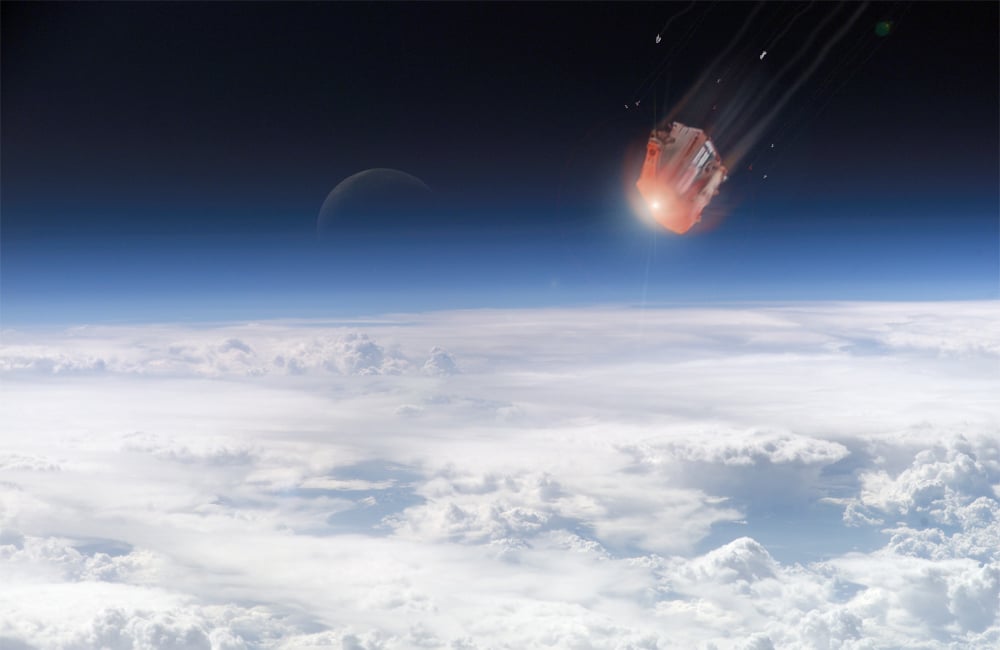[/caption]
The Early Ammonia Servicer (EAS), the
largest chunk of debris
ever jettisoned from the International Space Station (ISS) had a fight with Earth's atmosphere, and lost. Reports by amateur astronomers on November 2nd suggested that the speeding EAS had probably re-entered, as its expected orbital pass was not observed. Now calculations by US Space Command suggest any surviving EAS debris dropped into the
Indian Ocean
Pacific Ocean, 550km south of Tasmania, where any sightings of the resulting fireball would be unlikely...
The double-refrigerator-sized EAS
was dropped from the ISS on July 23rd, 2007
to begin its long spiral journey toward the Earth's atmosphere. At the time, NASA calculated that the EAS would take approximately 300 days to reach the planet below, but its degrading orbit took a little longer than expected. Eventually NASA was able to say for sure that the re-entry window would occur some time on Sunday (Nov. 2nd), 15 months after it was detached from the station. The operation to remove the defunct 1400 lb (635 kg) piece of equipment included a spacewalk lasted for nearly eight hours.
Although it might seem like a precarious decision by NASA to allow an uncontrolled re-entry of an object as big as the EAS -- especially as it was predicted that up to 15 pieces, some as big as 17.5 kg (40 lb), may survive re-entry, hitting the ground at 100 mph -- but the problems associated with keeping the ammonia-filled EAS on board the station were far more acute. After all, 70% of the Earth's surface is water, and the likelihood of debris impacting populated regions was very small. Even so, NASA warned, "
If anybody found a piece of anything on the ground Monday morning, I would hope they wouldn't get too close to it
."
The first news to come to light about the EAS demise came from an amateur astronomer in Horizon City, Texas, who was using a low-light camera to try to capture the November 2nd flyby. "
But the EAS did not appear
," said
Thomas Dorman on Sunday
. "
I think it is safe to assume EAS has reentered
."
Today, it would appear a better idea of the EAS re-entry location has been calculated. The EAS re-entered over the
Indian Ocean
South Pacific Ocean, south of Tasmania at nearly 5am GMT:
[Pacific Ocean]
More information about the EAS final orbital trajectory can be found on
the real-time satellite tracking website.
If any pieces of the EAS survived re-entry, it looks as if they fell into the
Indian Ocean
South Pacific Ocean without incident, and (so far) without any eye-witnesses...
Update (Nov. 4th):
[caption id="attachment_20684" align="alignnone" width="580" caption="Google Earth view of the EAS re-entry co-ordinates (Google/Ian O'Neill)"]
[/caption]
On following up a reader's comment on the EAS re-entry, I decided to do some research myself. With reference to the Google Earth snapshot above, it would appear the EAS debris fireball occurred pretty close (approximately 550 km) to the southern-most state of Australia, Tasmania.
Also, according to the original news release, the SpaceWeather.com source quoted the re-entry co-ordinates as 48° S, 151° E. The Indian Ocean is delineated from the Pacific Ocean
along the 147° east meridian
(i.e. 147° longitude). Therefore, at 151° E quoted as the longitudinal co-ordinate of re-entry is clearly in the South Pacific Ocean and
not
the Indian Ocean. Corrections to the original article have been made above.
Source:
SpaceWeather.com
 Universe Today
Universe Today
